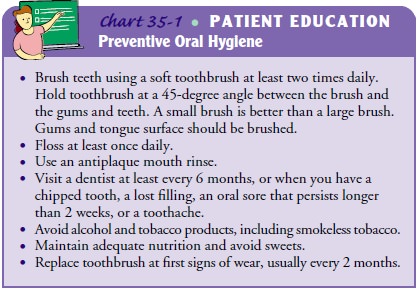Chapter: Medical Surgical Nursing: Management of Patients With Oral and Esophageal Disorders
Dental Plaque and Caries - Disorders of the Teeth
Disorders of the Teeth
DENTAL
PLAQUE AND CARIES
Tooth
decay is an erosive process that begins with the action of bacteria on
fermentable carbohydrates in the mouth, which produces acids that dissolve
tooth enamel. The extent of damage to the teeth depends on the following:
•
The presence of dental plaque
•
The strength of the acids and the ability of the
saliva to neu-thantralize them
•
The length of time the acids are in contact with
the teeth
•
The susceptibility of the teeth to decay
Dental
plaque is a gluey, gelatin-like substance that adheres to the teeth. The initial
action that causes damage to a tooth occurs under dental plaque.
Dental
decay begins with a small hole, usually in a fissure (a break in the tooth’s
enamel) or in an area that is hard to clean.Left unchecked, the affected area
penetrates the enamel into the dentin. Because dentin is not as hard as enamel,
decay progresses more rapidly and in time reaches the pulp. When the blood,
lymph vessels, and nerves are exposed, they become infected andan abscess may
form, either within the tooth or at the tip of the root. Soreness and pain
usually occur with an abscess. As the infection continues, the patient’s face
may swell, and there may be pulsating pain. The dentist can determine by x-ray
studies the extent of damage and the type of treatment needed. Treatment for
dental caries includes fillings, dental implants, and extractions. If treatment
is not successful, the tooth may need to be extracted. In general, dental decay
is associated with young people, but older adults are subject to decay as well,
particularly from drug-induced or age-related oral dryness (see the
accompanying GerontologicConsiderations box).
Prevention
Measures used to prevent and control dental caries include practicing effective mouth care, reducing the intake of starches and sugars (refined carbohydrates), applying fluoride to the teeth or drinking fluoridated water, refraining from smoking, controlling diabetes, and using pit and fissure sealants (Chart 35-1).

MOUTH CARE
Healthy
teeth must be conscientiously and effectively cleaned on a daily basis.
Brushing and flossing are particularly effective in mechanically breaking up
the bacterial plaque that collects around teeth.Normal mastication (chewing)
and the normal flow of saliva also aid greatly in keeping the teeth clean.
Because many ill patients do not eat adequate amounts of food, they produce
less saliva, which in turn reduces this natural tooth cleaning process. The
nurse may need to assume the responsibility for brushing the patient’s teeth.
In any case, merely wiping the patient’s mouth and teeth with a swab is
ineffective. The most effective method is mechanical cleansing (brushing). If
brushing is impossible, it is better to wipe the teeth with a gauze pad, then
have the patient swish an antiseptic mouthwash several times before expectorating
into an emesis basin. A soft-bristled toothbrush is more effective a sponge or
foam stick. The lips may be coated with a watersoluble gel to prevent drying.
DIET
Dental
caries may be prevented by decreasing the amount of sugar and starch in the
diet. Patients who snack should be encouraged to choose less cariogenic
alternatives, such as fruits, vegetables, nuts, cheeses, or plain yogurt.
FLUORIDATION
Fluoridation of public water supplies has been found to decrease dental caries. Some areas of the country have natural fluoridation; other communities have added fluoride to public water supplies. Fluoridation may be achieved also by having a dentist apply a concentrated gel or solution to the teeth, adding fluoride to home water supplies, using fluoridated toothpaste or mouth rinse, or using sodium fluoride tablets, drops, or lozenges.
PIT AND FISSURE SEALANTS
The
occlusal surfaces of the teeth have pits and fissures, areas that are prone to
caries. Some dentists apply a special coating to fill andseal these areas from
potential exposure to cariogenic processes.
These
sealants last up to 7 years.
Related Topics